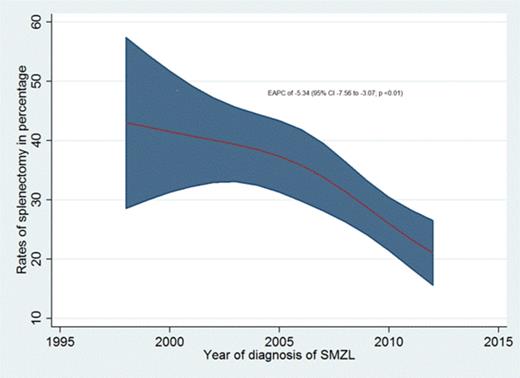Abstract
Introduction:
In the modern era, Rituximab (R) has been demonstrated to be a very effective therapy for patients with SMZL. Although there are no randomized controlled trials, historical data have demonstrated good outcomes with R alone, allowing patients to forego splenectomy as a treatment modality. Most recently however, a retrospective study from Vancouver showed superior outcomes with splenectomy as compared to chemotherapy in the front line setting. We aimed to determine the national trend in splenectomy rate for SMZL using a US population-based database.
Methods:
We utilized the SEER 18 database to identify all patients with SMZL between the years 1998-2012 using International Classifications of Disease for Oncology, 3rd edition (ICD-O-3) code 9689/3. Only cases with known age, race, stage, receipt of surgery and follow up information were included. Median Overall survival (OS) and 5-year OS were calculated using Kaplan Meier method. Using Poisson regression methods, we estimated the yearly splenectomy rate adjusting for age, gender and stage at diagnosis. Estimated annual percentage change (EAPC) was calculated as the antilog for the regression coefficient for year minus 1 times 100 [i.e. EAPC = {exp(year of diagnosis) -1} x 100].Flexible but smooth rate was obtained with restricted cubic splines using Akaike's information criteria. All p-values were two-sided and the level of significance was chosen at 0.05.
Results:
A total of 1368 patients with SMZL met eligibility criteria. The median age was 69 years (range 25-96 years). The study population comprised of 53% females(n=721) and 90% whites (n=1236). A total of 70% (n=951) were stage IV at diagnosis. A total of 40% (n=540) received splenectomy, whereas only 16 patients (1.2%) received radiation therapy. The receipt of chemotherapy could not be analyzed. The adjusted rate in splenectomy declined sharply from 79.5% in 1998 to 24.7% in 2012 at an EAPC of -5.34 (95% CI -7.56 to -3.07; p<0.01). Figure 1 shows the restricted cubic spline graph showing a decline in adjusted splenectomy rate during the study time period. The median and 5-year OS was 101 months and 66% respectively.
Conclusion:
Our population-based study demonstratesa steady decline in the rate of splenectomy for SMZL between 1998-2012. This declining rate is likely reflective of increasing use of R or R based chemotherapy regimens for the treatment of patients with SMZL. It also likely reflects to some extent improved pathologic characterization of this entity based on bone marrow evaluation alone, decreasing the need for a diagnostic splenectomy.
Restricted cubic spline graph showing the declining trend in splenectomy rate among patients with SMZL. The rate was adjusted for age, gender and stage at diagnosis.
Restricted cubic spline graph showing the declining trend in splenectomy rate among patients with SMZL. The rate was adjusted for age, gender and stage at diagnosis.
Armitage:Ziopharm: Consultancy; Conatus: Consultancy, Membership on an entity's Board of Directors or advisory committees; Tesaro Bio, Inc: Membership on an entity's Board of Directors or advisory committees; Spectrum: Consultancy; Roche: Consultancy; Celgene: Consultancy; GlaxoSmithKline: Consultancy, Membership on an entity's Board of Directors or advisory committees.
Author notes
Asterisk with author names denotes non-ASH members.


